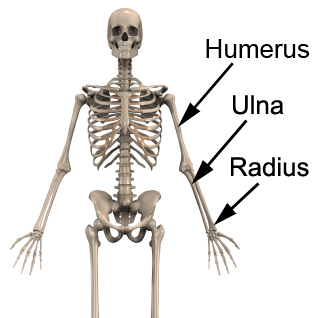Ulna Anatomy: Structure and Function
Updated:
The ulna is a long bone in the forearm that runs parallel to the radius, forming the medial (inner) border of the forearm. It is one of the two bones in the forearm, along with the radius, and plays a critical role in the movement and stability of the elbow, wrist and hand. In this article, we will explore the anatomy of the ulna, including its bony landmarks, muscular attachments, and related injuries.
Ulna Anatomy

Bony Landmarks of the Ulna
The ulna has two ends and a shaft. The proximal end of the ulna is the upper end that articulates with the radius and humerus at the elbow joint. The distal end of the ulna is the lower end that articulates with the bones of the wrist, including the pisiform, triquetral, and hamate bones. The shaft of the ulna is straight and has a rough surface, making the weaker of the two bones in the forearm.
The ulna also has several bony landmarks that provide attachment sites for ligaments and muscles. The olecranon process is a large, posterior prominence on the proximal end of the ulna that serves as the attachment site for the triceps brachii muscle. The coronoid process is a small, anterior prominence on the proximal end of the ulna that serves as the attachment site for the brachialis muscle. The styloid process is a small, pointed projection on the distal end of the ulna that serves as the attachment site for the ulnar collateral ligament of the wrist.
Ulna Anatomy: Muscular Attachments
The ulna has several muscular attachments that are important for the movement and stability of the wrist and hand. The flexor carpi ulnaris muscle attaches to the medial side of the ulna and helps to flex the wrist. The extensor carpi ulnaris muscle attaches to the lateral side of the ulna and helps to extend the wrist. The pronator quadratus muscle attaches to the distal end of the ulna and helps to rotate the forearm inward (pronation).
Injuries of the Ulna
The ulna is susceptible to various types of injuries due to its location and function. Fractures of the ulna can occur due to direct trauma or overuse injuries. These fractures can cause pain, swelling, and deformity of the forearm and wrist, requiring medical attention. Dislocations of the wrist joint can also cause damage to the ulna, causing pain and limited range of motion. Arthritis and tendonitis (of the relevant joints / muscles respectively) can also affect the ulna, causing pain and inflammation.
Conclusion
The ulna is a critical bone that plays an important role in the stability and mobility of the elbow, wrist and hand. Its bony landmarks and muscular attachments allow for a wide range of movement, while its weaker structure may potentially reduce its tolerance to force compared with the radius. Understanding the anatomy of the ulna can help to prevent and manage injuries, allowing for optimal function and performance of the elbow, wrist and hand joints.
Ulna Anatomy References:
“Ulna Bone Anatomy” by Healthline (https://www.healthline.com/human-body-maps/ulna-bone#1)
“Anatomy of the Ulna” by Teach Me Anatomy (https://teachmeanatomy.info/upper-limb/bones/ulna/)

Link to this Page
If you would like to link to this article on your website, simply copy the code below and add it to your page:
<a href="https://physioadvisor.com.au/ulna-anatomy-structure-and-function”>Ulna Anatomy: Structure and Function – PhysioAdvisor.com</a><br/>Learn about Ulna anatomy structure and function including bony landmarks, muscle attachments and common injuries on PhysioAdvisor
Return to the top of Ulna Anatomy: Structure and Function.
